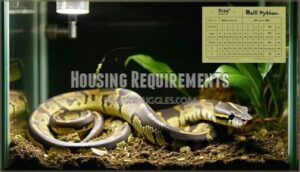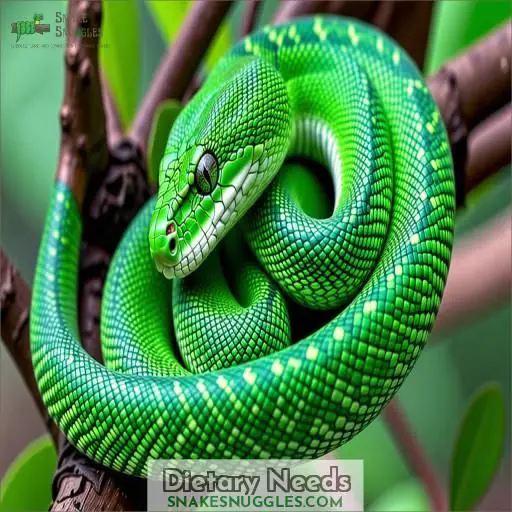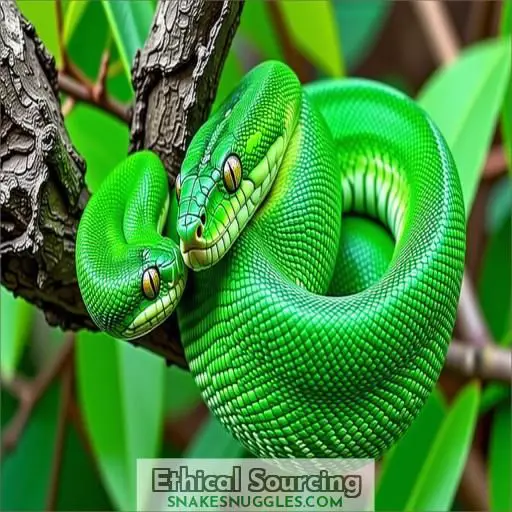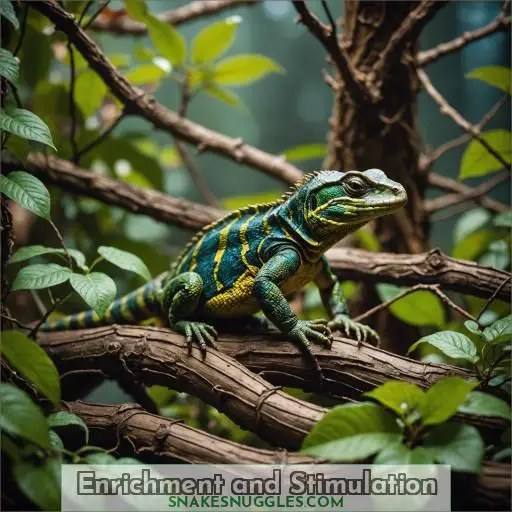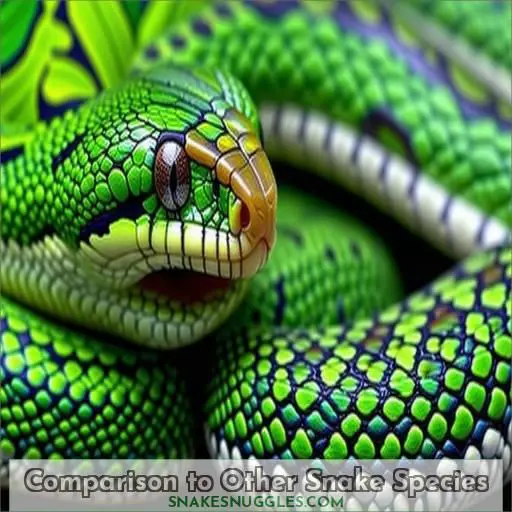This site is supported by our readers. We may earn a commission, at no cost to you, if you purchase through links.
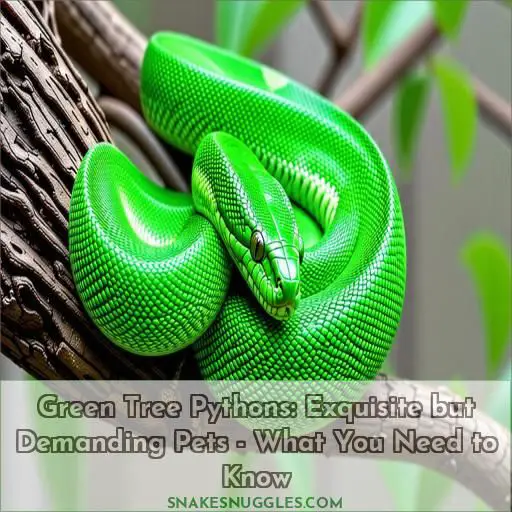 Green tree pythons are exquisite but demanding pets that require meticulous care.
Green tree pythons are exquisite but demanding pets that require meticulous care.
While their striking beauty captivates many enthusiasts, their defensive nature and propensity for biting make them challenging to handle, especially for beginners.
Providing the proper enclosure, heating, lighting, and humidity levels is essential for their well-being.
These ambush predators also have specific dietary needs, requiring appropriately sized prey.
With regular veterinary checkups and proper husbandry, green tree pythons can make rewarding companions – but only for experienced reptile keepers willing to invest the time and effort they demand, especially considering their defense mechanisms.
For those up to the task, these enchanting serpents offer a glimpse into the remarkable world of arboreal snakes.
Table Of Contents
- Key Takeaways
- Are Green Tree Pythons Good Pets?
- Temperament and Handling
- Housing Requirements
- Dietary Needs
- Health Considerations
- Legality and Licensing
- Lifespan and Commitment
- Ethical Sourcing
- Enrichment and Stimulation
- Comparison to Other Snake Species
- Frequently Asked Questions (FAQs)
- Do green tree pythons like being held?
- Are green tree pythons hard to keep?
- Does a green tree python bite hurt?
- Can green tree pythons be tamed?
- What are the typical enclosure dimensions for green tree pythons?
- How does the behavior of green tree pythons differ from other snake species?
- What heating and lighting requirements are essential for green tree pythons?
- What is the average lifespan of green tree pythons in captivity?
- What are the common health issues faced by green tree pythons?
- Conclusion
Key Takeaways
- Green tree pythons have specific habitat requirements, including proper enclosure size, heating, lighting, and humidity levels, which can be challenging to maintain
- These snakes are known for their defensive nature and tendency to bite, making them difficult to handle, especially for beginners
- Providing a varied diet of appropriately sized prey and regular veterinary check-ups is essential for their well-being
- Green tree pythons require a significant long-term commitment, as they can live 15-20 years in captivity, and their care necessities must be met for their entire lifespan
Are Green Tree Pythons Good Pets?
Green tree pythons can be alluring but pose certain challenges as pets.
Their care necessities, including specific habitat requirements, heating, and lighting, should be thoroughly considered.
Additionally, their reserved nature and possibility for aggression raise temperament concerns, necessitating cautious socialization and reptile handling.
Ethical considerations are also imperative, as acquiring green tree pythons from reliable breeders ensures the well-being of the species.
Their arboreal lifestyle must be provided for in their habitat, emphasizing the necessity of climbing branches and hiding spots.
Evaluating the suitability of green tree pythons as pets involves a holistic understanding of their needs, including their unique behaviors and the long-term commitment required for their proper care.
Temperament and Handling
Green Tree Pythons are known for their tendency to be defensive and prone to strike if startled or mishandled. However, with proper socialization from a young age, their aggression can be reduced, allowing them to become calmer and more accustomed to gentle handling over time.
Aggression and Biting
Green tree pythons are known for their aggressive temperament and painful bites. While they’re non-venomous, their sharp teeth can cause significant injury. Provoked bites are common if the snake feels threatened, often displaying defensive postures like gaping and striking. Proper handling techniques and minimizing interactions are essential, as anti-venom isn’t readily available for green tree python bites.
- Avoid provoking the snake by approaching from above or grabbing it directly.
- Always support the snake’s entire body when handling to prevent injury.
- Limit handling to essential care tasks, as these snakes don’t enjoy frequent interactions.
Socialization and Taming
While green tree pythons can be aggressive when startled, with patience and consistent handling, you can tame them down. Use a gentle, confident approach, always supporting their body. Offer treats during interactions to associate you with positive experiences. Avoid handling during feeding times. With time and care, these shy snakes can become calmer pets (Source).
Housing Requirements
When housing green tree pythons, you’ll need to create an appropriately-sized enclosure with proper heating, lighting, and humidity levels. These arboreal snakes thrive in vertically-oriented enclosures that mimic their rainforest environment, with ample climbing branches, basking areas, and hiding spots to meet their specific environmental needs.
Enclosure Size and Type
When setting up an enclosure for your Green Tree Python, guarantee the minimum size is 60 cm long by 90 cm high.
Glass enclosures are preferred over plastic for their durability and easy maintenance.
Provide vertical space with horizontal branches for your arboreal python.
Consider insulating the enclosure to maintain the necessary temperature.
Heating and Lighting
Maintaining proper heating and lighting is essential for your green tree python’s health.
Provide a basking spot of 88-90°F and a cooler area around 80°F.
Use a ceramic heater and thermostat to regulate temperatures.
Supplement with UVB lighting for 12 hours daily to mimic natural daylight.
Insulate the enclosure to retain heat efficiently.
Proper heating and lighting are vital for your pet’s wellbeing.
Humidity and Substrate
To create a suitable habitat for your Green Tree Python, maintain a cleanliness schedule for the substrate, ensuring proper hygiene and reducing the risk of health issues.
Monitor humidity levels regularly and maintain them within the recommended range of 40-70%.
Select an appropriate substrate depth that allows the python to exhibit natural behaviors. This is vital for the overall care of your python and its habitat.
Dietary Needs
Regarding feeding your green tree python, you must provide suitably sized rodents or other prey items at regular intervals. These snakes usually consume food every 7-10 days during their juvenile stage and every 10-14 days as adults, with the prey size gradually increasing from small mice to adult rats as they mature.
Feeding Schedule
Green tree pythons have specific feeding requirements based on their age. Babies need to eat about twice a week, while adults can be fed every 10-14 days . Observe your snake’s activity level to determine when it’s hungry. Offer appropriately sized prey, and monitor feedings to make sure your pet gets the nutrition it needs to thrive.
- Establish a consistent feeding schedule
- Provide a varied diet of rodents and birds
- Adjust portions as your snake grows
Prey Size
When feeding your green tree python, choose appropriately sized prey like mice or rats.
Babies can eat pinkies every 5-7 days, while adults only need a medium rat every 2-4 weeks.
Supplement with calcium and vitamin D3 to maintain proper nutrition.
Green tree pythons are ambush predators, so offer food at night when they’re most active.
With proper feeding, your pet will flourish!
Health Considerations
As exquisite as green tree pythons may appear, they’re susceptible to various health issues that require attentive care and regular veterinary checkups. Failure to maintain proper humidity levels or provide adequate heat can lead to respiratory infections, shedding difficulties, and other complications that may negatively impact their well-being.
Common Health Issues
Green tree pythons are prone to health issues like dry skin, respiratory problems, and shedding difficulties if humidity levels are improper (Source). Skin problems can arise from low humidity, while respiratory issues stem from drafts and excess ventilation . Shedding issues are common with inadequate moisture . Consult a reptile vet if you notice any health problems with your green tree python.
Veterinary Care
When caring for Green Tree Pythons, regular veterinary appointments are essential for parasite prevention, disease outbreaks, and emergency treatment. Considering potential health issues and the specialized habitat of tropical rainforests, health insurance can provide peace of mind like rainforest snake adaptations. The striking green color and prehensile tail are adaptations for camouflage and defense against predators in their natural environment.
Legality and Licensing
Before acquiring a green tree python as a pet, it’s imperative to research and understand the legality and licensing requirements in your specific state or territory. While some areas allow private ownership with the proper permits, others have stricter regulations or outright bans on keeping these snakes, so checking the local laws is a must.
State-specific Requirements
Owning a green tree python varies by state. Some states require a license, while others prohibit private ownership. Before getting one, research your state’s specific regulations to guarantee compliance. Transporting these snakes across state lines may also have restrictions. Prioritize the snake’s welfare by sourcing from reputable breeders and providing proper care, regardless of your location.
Permits and Regulations
Before bringing home a green tree python, check your state’s regulations.
Many require permits or licenses for reptile ownership. Some prohibit private ownership entirely.
Confirm that you meet all requirements, like microchipping, insurance, and restrictions on breeding or importing. Buying online may be limited.
Consult your local wildlife agency to understand the legal responsibilities of keeping these stunning snakes as pets.
Lifespan and Commitment
Green tree pythons have an average lifespan of 15-20 years in captivity, potentially reaching over 25 years with excellent care. This longevity requires a significant commitment from owners, as these snakes demand specialized housing, heating, and humidity control for their entire lives.
Average Lifespan
Green tree pythons have an average lifespan of 15-20 years, with some reaching over 20 years in captivity. To guarantee their welfare and longevity, it’s necessary to provide appropriate housing, heating, and humidity. Regular veterinary care and a balanced diet are also important for maintaining their health and reaching their maximum lifespan. Understanding their reproductive habits and growth rate can further enhance your ability to care for them effectively.
- Maintaining appropriate housing, heating, and humidity
- Regular veterinary care
- Balanced diet for overall health
- Understanding reproductive habits and growth rate (Source)
Long-term Care
Caring for a green tree python is a long-term commitment.
These snakes can live 15-20 years with proper care.
Involve a herpetologist for assisted reproduction to maintain genetic diversity and safeguard welfare.
Provide enrichment like climbing branches and hiding spots to keep your python stimulated.
Be prepared for the responsibility of caring for this exquisite but demanding pet for decades to come.
Ethical Sourcing
When considering a green tree python as a pet, you’ll want to ascertain the animal is sourced ethically from a reputable breeder. Avoid wild-caught specimens, as this practice can deplete native populations and contribute to unsustainable wildlife trade.
Reputable Breeders
When sourcing a green tree python, always buy from a reputable breeder. Look for breeders who:
- Prioritize genetic diversity in their breeding programs
- Provide veterinary expertise and proper handling equipment
- Support conservation efforts through captive breeding
Reputable breeders guarantee the health and wellbeing of their pythons, giving you the best chance at a long-lived, well-adjusted pet.
Avoiding Wild-caught Specimens
Avoid wild-caught green tree pythons at all costs. Captive breeding is essential for maintaining genetic diversity and a sustainable population. Reputable breeders prioritize the health and welfare of their snakes. While cheaper, wild-caught specimens often suffer from stress, parasites, and poor health. Support conservation efforts by choosing a captive-bred green tree python from a responsible breeder.
Enrichment and Stimulation
Green tree pythons are arboreal snakes that require sufficient climbing opportunities within their enclosure. Providing ample horizontal branches, secure vertically-mounted logs, and various hiding spots will allow these active snakes to engage in their natural climbing behaviors and thermoregulate properly.
Climbing Branches
To meet the arboreal needs of Green Tree Pythons, provide sturdy tree perches for climbing and exploration. Incorporate live foliage to mimic their natural habitat, offering both enrichment and stimulation. Basking platforms at varying heights create temperature and humidity gradients, essential for their well-being as arboreal species. These elements enhance their environment and promote their physical and mental health.
Hiding Spots
Provide your green tree python with ample hiding spots to feel secure and stimulated. Use a variety of textures like cork bark and driftwood, and vary the size and placement of hides. Clutter the enclosure with live plants and climbing structures to create a naturalistic environment that encourages exploration and activity.
Comparison to Other Snake Species
When compared to other popular pet snake species like corn snakes or ball pythons, green tree pythons generally require more specialized care and a greater time commitment. However, their striking beauty and unique arboreal nature make them an alluring choice for experienced reptile enthusiasts willing to meet their demanding husbandry needs.
Ease of Care
When considering the ease of care for Green Tree Pythons, it’s imperative to grasp their behavior, temperament, handling, enclosure, and maintenance requirements.
These snakes, renowned for their vibrant green color and unique prehensile tails, have specific needs due to their natural habitat in tropical rainforests.
They require precise temperature ranges, humidity levels, and specialized enclosures to thrive, making their care relatively more demanding compared to some other snake species.
Popularity as Pets
While green tree pythons are stunning with their vibrant colors, they’re not the easiest snakes to keep as pets. Their rainforest habitat requires precise temperature and humidity, and they can be aggressive if not properly socialized. Ethical breeders are essential to avoid wild-caught specimens that may have health issues. Consider your commitment before getting one as a pet.
Frequently Asked Questions (FAQs)
Do green tree pythons like being held?
Ironically, the ‘tree‘ in their name hints at the opposite – these snakes aren’t fans of cuddling. While docile with proper socialization, they prefer observing their surroundings from the security of branches and hides.
Are green tree pythons hard to keep?
Green tree pythons require dedicated care and specialized environments. Creating proper humidity, heating, and enclosure sizes can be challenging for beginners. With experience, however, their unique care can be manageable and rewarding.
Does a green tree python bite hurt?
Oh yes, their bite packs a punch! While not venomous, their sharp teeth can draw blood and leave you with an unpleasant souvenir.
Can green tree pythons be tamed?
While they’re often quite aggressive initially, green tree pythons can indeed become tamed through patient, frequent handling from a young age. With proper socialization, their notorious feisty nature can potentially be relaxed over time.
What are the typical enclosure dimensions for green tree pythons?
For green tree pythons, you’ll need a tall enclosure – at least 60 inches high by 36 inches long by 24 inches deep. These arboreal snakes require ample vertical space for climbing and plenty of branches.
How does the behavior of green tree pythons differ from other snake species?
Ironically, while stunning, green tree pythons aren’t cuddly pets. Unlike some snakes, they’re solitary, aggressive hunters, prone to biting when startled. Their care requires meeting strict environmental needs – not for beginners.
What heating and lighting requirements are essential for green tree pythons?
You’ll need a basking spot around 86-88°F, a cooler end of 78-80°F, and UV lighting to mimic their natural environment. Proper heating and lighting are essential for these vibrantly-colored snakes to thrive.
What is the average lifespan of green tree pythons in captivity?
Like emeralds gleaming through branches, green tree pythons thrive in captivity, with lifespans averaging 20-25 vibrant years with proper care – a living jewel to delight reptile enthusiasts.
What are the common health issues faced by green tree pythons?
You’ll want to watch out for respiratory issues, shedding problems, and dry skin – these often stem from improper humidity levels. With the right care, though, these snakes can thrive for decades.
Conclusion
Ultimately, green tree pythons’ striking beauty belies their demanding care requirements. While they can make rewarding pets for experienced reptile keepers, their propensity for aggression, specific housing needs, and dietary demands necessitate substantial commitment. Prospective owners must thoroughly research these exquisite yet high-maintenance snakes to determine if they’re prepared to provide the dedicated care green tree pythons require.


